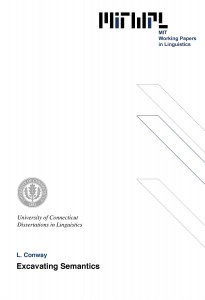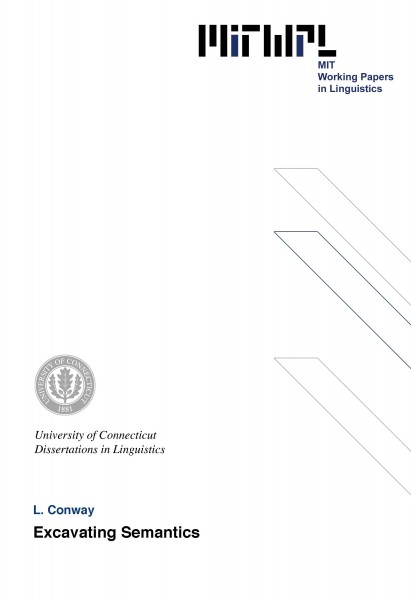Excavating Semantics
L. Conway, 1997
Abstract
The generative framework for linguistic study (e.g., Chomsky 1957, 1980, 1986) recognizes two types of linguistic knowledge: knowledge of language which abstracts away from language use, called grammar, and knowledge of language pertaining to language use, called pragmatics. This thesis examines two consequences of drawing such a distinction in linguistic knowledge. The first half of the thesis examines the domain of grammatical knowledge. According to Chomsky and many other generative linguistics, the domain of grammar is the sentence. I present evidence which invites a revision of this position. Considering a specific problem in discourse, the interpretation of pronominal reference in discourses such a those in (1), I argue for grammatical knowledge governing certain aspects of discourse construction.
(1) a. A dog walked in. It lay down under the table.
b. Every worker stopped at the picket line. They denounced the companys policies.
In both of the discourse segments in (1), the pronouns refer to discourse referents introduced as an automatic consequence of the preceding quantified noun phrase (Evans 1977, 1980; Heim 1982; karttunen 1974, 1976). The singular pronoun in (1a) refers to the dog introduced by virtue of the indefinite, a dog. Similarly, the plural pronoun in (1b) refers to the collection of workers introduced by virtue of the expression every worker. These connections are thought to engage pragmatic rather than grammatical knowledge. Drawing on arguments from modularity and language acquisition, I show that a pragmatic analysis of these facts is both insufficient and unnecessary.
The second half of the thesis addresses a methodological problem arising from the distinction between grammar and pragmatics. Although generative researchers have made a conscious decision to study principles of grammar and principles of pragmatics separately, the evidence on which linguistic theories are based is not so neatly divided. Linguistic evidence must, of necessity, be obtained through channels of language use. Consequently, the available evidence reflects contributions of both grammatical and pragmatic resources. Inferring grammatical knowledge from this composite evidence is hazardous enterprise, particularly in the study of semantics. Concentrating on the semantics of quantification, I advance a systemic process for extracting truth-conditional semantics from the available sources of semantic evidence.
Table of Contents
Introduction 1
Chapter 1
A Grammar of Discourse
1 Toward Usage-independent Knowledge of Language 9
2 Usage-independent Properties of Meaning 15
3 A Grammar for Discourse? 21
3.1 Discourse Anaphora: The Facts 25
3.2 Discourse Anaphora is Pragmatic 29
3.3 The Functional Analysis of Unbound Anaphora 33
3.4 Problems with the Functional Analysis 36
3.5 Grammatical Connections in Discourse 44
4 Discourse Anaphora is Usage-Independent 46
4.1 Discourse Pronouns have a Semantic Referent (a la Grice/Kripke) 47
4.2 Linguistic Constraints, Modularity and Language Acquisition 50
Chapter 2
Experimental Preliminaries
1 Architectural Assumptions 57
1.1 The Innateness of Linguistic Constraints 58
1.2 Modularity and the Special Status of Grammatical Knowledge 62
2 The Truth-Value Judgment Task 66
3 Personalizing the Truth Value Judgment Task 77
3.1 Testing for Linguistic Constraints 77
3.2 Testing for Knowledge of Ambiguity 81
3.3. Finishing Touches 85
4. The TVJT in Action 87
Chapter 3
Experimental Investigations of Discourse Anaphora
1 Experiment 1: Discourse Anaphora with Singular Pronouns 90
1.1 Participants 94
1.2 Method 95
1.3 Materials 95
1.4. Results 100
1.5 Discussion 104
2. Experiment 2: Discourse Anaphora with Plural Pronouns 109
2.1 Participants 113
2.2 Method 113
2.3 Materials 114
2.4 Results 120
2.5 Discussion 123
3. Experiment 3: An Additional Property of Plural Anaphora 126
3.1 Participants 128
3.2 Method 129
3.3 Materials 129
3.4 Results 131
3.5 Discussion 133
4. General Discussion 134
Chapter 4
Competing Accounts of Discourse Anaphora
1 The Donkey Debate 139
2 E-Type Reference 144
2.1 Uniqueness Implications of E-type Reference 146
3 Every as an Unselective Quantifier 151
3.1 Aspects of Unselective Binding 152
3.2 Auxiliary Interpretations of Donkey Sentences 155
3.3 Criticisms of the Unselective Binding Analysis 157
4 Dynamic Binding 160
4.1 Aspects of Dynamic Binding 162
4.2 Strong Readings for Relative Clause Donkey Sentences 165
4.3 The Interpretation of Conditionals 167
4.4 Distinguishing Features of Dynamic Binding 170
5 Predictions for Child Language 172
Chapter 5
Experimental Investigations of Donkey Anaphora
1 Experiment 4: Donkey Sentences Formed with Every 178
1.1 Participants 181
1.2 Method 181
1.3 Materials 182
1.4 Results 190
1.4.1 Relative Clause Donkey Sentences 190
1.4.2 Conditional Donkey Sentences 193
1.5 Discussion: Relative Clause and Conditional Donkey Sentences 195
1.6 A Further Implication 199
2 Experiment 5: Donkey Sentences Containing Negation 201
2.1 Participants 203
2.2 Method 203
2.3 Materials 204
2.4 Results 209
2.5 Discussion 212
3. Summary 221
Chapter 6
From Semantic Evidence to Semantic Analysis
1 The Representation of Semantic Knowledge 225
2 Types of Semantic Evidence 226
2.1 On-line Context Generation: Evidence From Language Processing 232
2.1.1 Economy Pressures on the Construction of a Mental Context 232
2.1.1 Semantic Determinants of On-line Context Generation 236
2.2 Off-line Context Generation 239
2.3 Contexts of Felicitous Use 244
2.4 Context Verification: The Truth-Judgment 247
2.5 Summary 252
3 Solving for Unknowns 253
3.1 Solving Algebraic Systems 256
3.2 Solving Semantic Systems 257
3.3 Summary 261
4 Semantic Evidence and Donkey Anaphora 261
4.1 Evidence from On-line Context Generation 262
4.2 Off-line Context Generation 265
4.3 Contexts of Felicitous Use 265
4.4 Truth-Judgments and Donkey Anaphora 268
5 Solving the Donkey Anaphora System 269
5.1 Truth-Value Judgment Revisited 271
5.1.1 Strong Truth-Conditions are Primary 271
5.1.2 Strong Truth-Conditions are Primary 276
5.2 The Pragmatic Strategy at Work 280
5.3 Experiment 4 Results Explained 283
5.4 An Underlying Semantics for Donkey Sentences 286
5.6 Fitting Together the Pieces 288
6 An Ode to Uniqueness 289
7 Concluding Remarks 291
References 293

